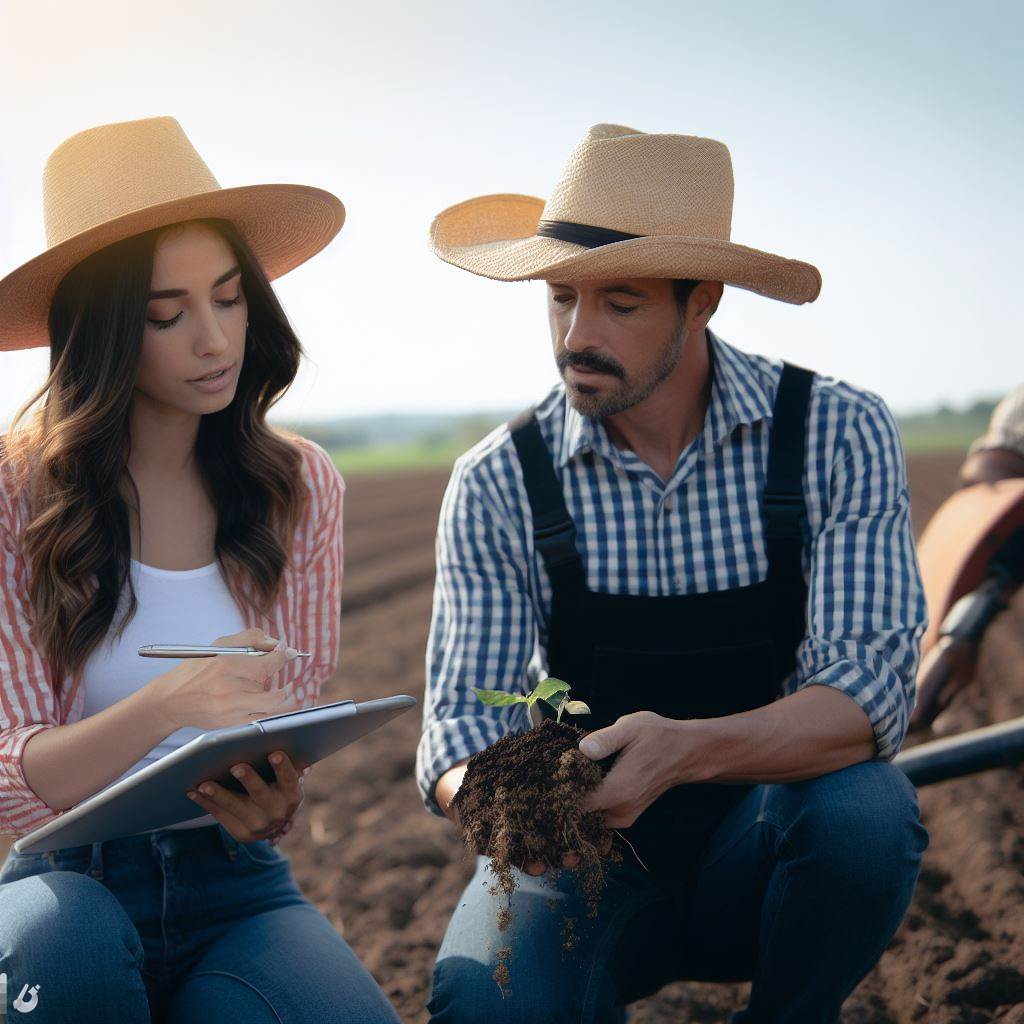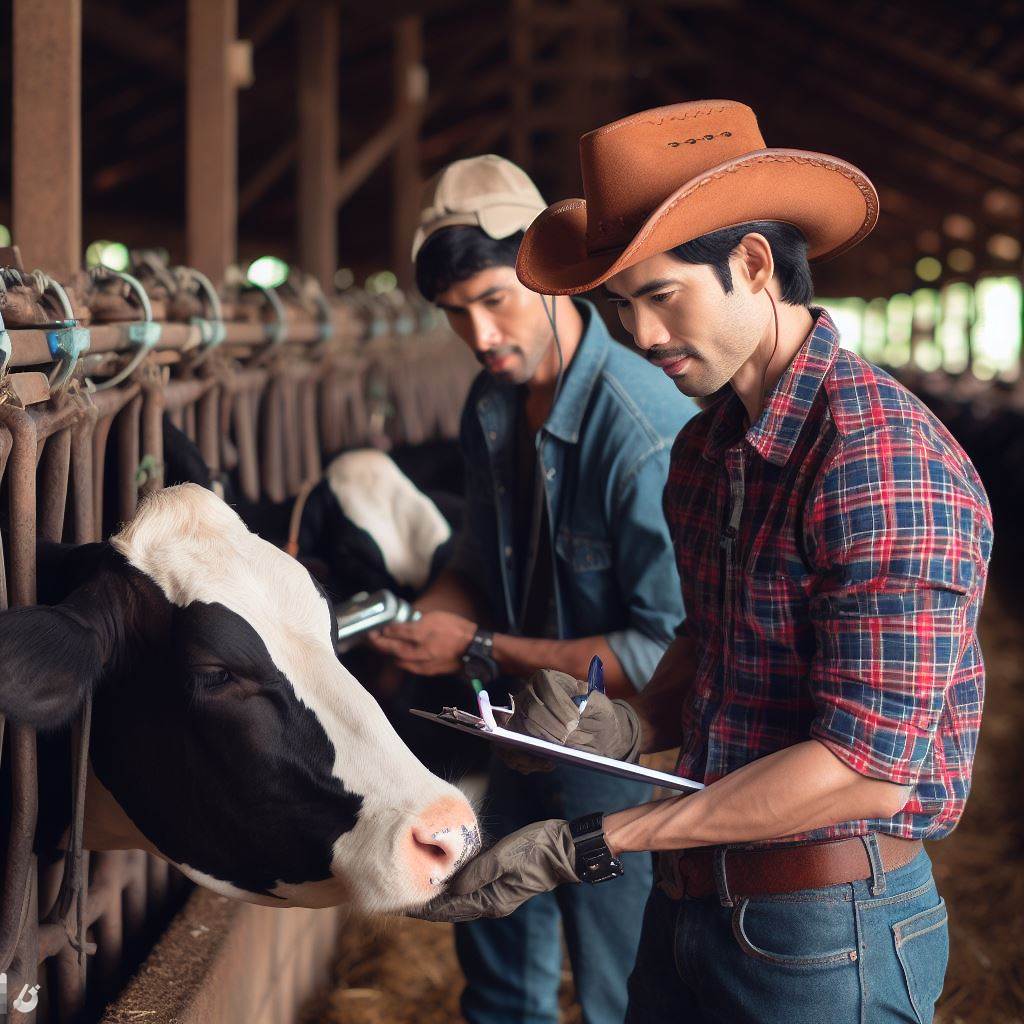Introduction
Crop yield optimization plays a crucial role in improving agricultural productivity and sustainability.
Soil sensors are instrumental in providing valuable insights to enhance crop yield. This blog post aims to explore the impact of these sensors on optimizing crop yield.
A. Importance of crop yield optimization in agriculture
Crop yield optimization is crucial for farmers and the entire agricultural industry.
Maximizing crop yield ensures food security, reduces waste, and improves profitability for farmers.
With a growing global population, it is vital to utilize resources efficiently and increase productivity sustainably.
B. Role of soil sensors in enhancing crop yield insights
They are innovative devices that collect data on soil moisture, temperature, pH levels, and nutrient content.
This data helps farmers make informed decisions about irrigation, fertilization, and pest control.
By accurately monitoring soil conditions, farmers can optimize crop growth, minimize resource wastage, and prevent yield loss.
C. Purpose of the blog post
The purpose of this blog post is to highlight the significance of these sensors in maximizing crop yield by providing real-time information about soil conditions.
It aims to educate readers on the advantages of using sensors in agricultural practices and the potential impact on overall crop productivity.
By embracing this technology, farmers can make more precise and data-driven decisions.
This, in turn, leads to increased crop yield, improved resource efficiency, and ultimately contributes to a sustainable and thriving agricultural sector.
Stay tuned for the upcoming sections, where we dive deeper into the benefits and applications of these sensors in enhancing crop yield insights.
What are Soil Sensors?
These sensors, crucial in agriculture, measure parameters like moisture, temperature, pH, and nutrients, optimizing crop yield and sustainability.
Different types include:
Transform Your Agribusiness
Unlock your farm's potential with expert advice tailored to your needs. Get actionable steps that drive real results.
Get StartedA. Moisture Sensors
- Measure water content.
- Assist in informed irrigation decisions.
B. Temperature Sensors
- Measure soil temperature.
- Essential for understanding plant growth patterns.
C. pH Sensors
- Measure soil acidity or alkalinity.
- Indicate soil suitability for different crops.
D. Nutrient Sensors
- Measure essential nutrient levels.
- Help determine required fertilizer amounts for optimal growth.
Advanced sensors include:
- Soil salinity sensors: Crucial for managing salt content, preventing soil degradation.
- Soil compaction sensors: Measure soil density and hardness, providing insights into soil structure.
Modern sensors feature wireless connectivity, transmitting real-time data to central systems.
This connectivity allows farmers to:
- Monitor soil conditions remotely.
- Make informed, data-driven decisions.
Benefits of utilizing soil sensors in agriculture include:
- Optimizing irrigation and fertilization reduces water usage and nutrient wastage.
- Early problem detection enables prompt interventions, preventing crop stress.
- Enhances overall farm productivity and sustainability.
As technology advances, soil sensors are expected to become:
- More accurate.
- Affordable.
- User-friendly.
By harnessing soil sensors, farmers can maximize yields while minimizing environmental impact in a more sustainable agriculture future.
Read: Vertical Farming: The Rise of Urban Agriculture
Why are Soil Sensors Important for Crop Yield Insights?
Understanding soil conditions is of utmost importance in optimizing crop yield.
Soil sensors play a crucial role in providing valuable insights and aiding farmers in their decision-making process.
A. Importance of understanding soil conditions
- Soil sensors provide real-time data on key soil parameters such as moisture content, temperature, and nutrient levels.
- This information allows farmers to make informed decisions regarding irrigation, fertilization, and other agricultural practices.
- By understanding the soil conditions, farmers can adjust their strategies to ensure optimal crop growth and maximize yield.
- Soil sensors help in identifying potential issues such as nutrient deficiencies or excessive moisture, enabling timely interventions to prevent yield losses.
- They also aid in the conservation of resources by minimizing water and fertilizer usage, resulting in cost savings while promoting environmental sustainability.
B. Ways soil sensors help in optimizing crop yield
- By continuously monitoring soil moisture levels, sensors assist farmers in implementing precise irrigation practices.
- This prevents both under-watering and over-watering, which can negatively impact plant growth and yield.
- Soil sensors also provide valuable insights on nutrient availability in the soil, allowing farmers to optimize fertilization schedules and application rates.
- By supplying crops with the right amount of nutrients at the right time, farmers can enhance their growth and productivity.
- Temperature monitoring through soil sensors helps in understanding the impact of temperature on crop development and enables farmers to take appropriate measures for protection.
C. Examples of successful implementation of soil sensors in agriculture
- In a study conducted in a vineyard, soil sensors were utilized to optimize irrigation practices.
- By measuring soil moisture levels, the irrigation system was adjusted to deliver water only when necessary, resulting in water savings of up to 30% while maintaining yield.
- Another example is the use of soil sensors for precision fertilization in a cornfield.
- By analyzing nutrient levels in different areas of the field, fertilizers were applied only where needed, leading to cost savings and improved crop quality.
- Furthermore, in a citrus orchard, soil sensors helped in managing soil moisture levels and preventing water stress in trees.
- This resulted in healthier trees, higher fruit quality, and increased yield.
In short, soil sensors play a crucial role in enhancing crop yield insights.
Understanding soil conditions allows farmers to make informed decisions, optimize agricultural practices, and maximize crop productivity.
Successful implementation of soil sensors in various agricultural settings has demonstrated their effectiveness in conserving resources, improving crop quality, and increasing yields.
With the advancements in sensor technology, the future holds promising possibilities for further integrating soil sensing into precision agriculture.
Read: Automated Tractors: The Future of Ploughing
How do Soil Sensors Work?
Soil sensors utilize innovative technology to gather crucial data about soil conditions.
They enable farmers to make informed decisions, resulting in enhanced crop yield.
Let’s delve into the technology behind soil sensors and understand how they work.
A. Overview of the technology behind soil sensors
Soil sensors operate based on the principle of measuring various soil parameters such as moisture, temperature, and nutrient levels.
These sensors employ cutting-edge technology to provide accurate insights.
B. Explanation of different components and their roles in measuring soil conditions
- Probe: The probe is the component that goes into the ground and comes in direct contact with the soil. It houses various sensors to collect data.
- Sensors: Soil sensors consist of different types of sensors, including moisture sensors, temperature sensors, and nutrient sensors. Each sensor measures a specific soil parameter.
- Data Logger: The data logger receives the readings from the sensors and stores the collected data. It acts as a bridge between the sensors and the user interface.
- User Interface: The user interface allows farmers to access the collected data and analyze it. It presents the information in an easily understandable format.
C. Step-by-step process of using soil sensors in the field
- Installation: The soil sensors are installed at specific locations in the field, ensuring they represent the soil conditions accurately.
- Data Collection: The sensors continuously monitor the soil parameters and collect data at regular intervals.
- Data Transmission: The sensors transmit the collected data to the data logger, which stores it for further analysis.
- Data Analysis: The farmer accesses the data through the user interface, allowing them to analyze the soil conditions and make informed decisions.
- Decision Making: Based on the analyzed data, the farmer can adjust irrigation, fertilization, and other farming practices to optimize crop yield.
Soil sensors revolutionize farming by providing real-time information about soil conditions, empowering farmers to make data-driven decisions.
With precise knowledge about moisture, temperature, and nutrients, farmers can apply the right interventions at the right time, fostering healthy crop growth.
Read: Agri Solar Panels: Powering Farms Sustainably

Benefits and Limitations of Soil Sensors
A. Advantages of using soil sensors for crop yield insights
- Accurate and real-time data collection on soil moisture, temperature, and nutrient levels.
- Improved crop management by providing insights on the optimal irrigation and fertilization requirements.
- Promotes water conservation by preventing over-irrigation and minimizing water wastage.
- Enhanced decision-making for farmers by identifying areas of the field that need attention.
- Increased crop yield and quality through precise and targeted application of resources.
- Reduction in fertilizer and water usage, leading to cost savings and environmental benefits.
- Enhances sustainable agricultural practices by minimizing the use of chemicals and increasing efficiency.
- Early detection of potential disease outbreaks or pest infestations, enabling timely intervention.
B. Potential limitations or challenges of using soil sensors
- Costly initial investment for purchasing, deploying, and maintaining soil sensor systems.
- Complexity in interpreting data for farmers not familiar with soil science or technology.
- Issues with sensor calibration, accuracy, and inconsistencies in data across different sensor brands.
- Reliability concerns, as sensors may malfunction or require regular maintenance and calibration.
- Limited coverage area per sensor, requiring multiple sensors for large or irregularly shaped fields.
- Difficulties in integrating sensor data with existing farm management systems.
C. Strategies to overcome these limitations
- Cost-sharing programs or subsidies to reduce the financial burden of soil sensor adoption.
- Training and education programs to improve farmers’ understanding of soil sensor data interpretation.
- Collaboration with experts in soil science or agronomy to ensure accurate data analysis.
- Regular maintenance and calibration schedules to ensure sensor reliability and performance.
- Using a network of sensors strategically placed across the field to increase coverage area.
- Development of user-friendly software or apps that integrate sensor data with farm management systems.
Case Studies or Success Stories of Using Soil Sensors
Soil sensors have revolutionized the way farmers and agricultural companies approach crop yield optimization.
Through real-life examples and success stories, we can see the tangible benefits that soil sensors bring to the table.
Showcase Your Farming Business
Publish your professional farming services profile on our blog for a one-time fee of $200 and reach a dedicated audience of farmers and agribusiness owners.
Publish Your ProfileLet’s dive into some case studies that showcase the power of soil sensors in enhancing crop yield insights.
A. Real-life examples of farmers or agricultural companies utilizing soil sensors
- Farmer John, a corn grower from Iowa, decided to implement soil sensors on his farm to enhance irrigation management.
By monitoring soil moisture levels in real-time, he was able to optimize his watering schedule and significantly reduce water usage. - E. & J. Gallo Winery, an innovative agricultural company, integrated soil sensors into their precision farming solutions.
They provided their services to several farmers, helping them make data-driven decisions regarding nutrient management, irrigation, and pest control.
B. Results and outcomes achieved through the use of soil sensors
- Farmer Jane had been struggling with low crop yields for years. But when she started using these sensors, she saw a remarkable improvement in her harvest.
By tailoring her fertilizer application based on soil nutrient levels, she achieved a 20% increase in crop yield. - The Climate Corporation, a large-scale farming operation, adopted these sensors to tackle an issue of inconsistent soil moisture across their fields.
With the help of irrigation automation systems driven by soil sensor data, they achieved uniform moisture levels, resulting in improved crop quality and yield.
C. Lessons learned and takeaways from these case studies
- They enable farmers and agricultural companies to make informed decisions. By collecting accurate and real-time data, they can fine-tune their agricultural practices, leading to optimized crop yields.
- Integration of these sensors with precision farming technologies can significantly enhance overall farm productivity and reduce resource wastage.
- It is essential to understand the specific needs of individual crops and tailor soil sensor deployment accordingly. Different crops may require different sensor placements, such as varying depths or distances from plants.
- The success stories of farmers and agricultural companies using these sensors highlight the importance of continuous monitoring and analysis of the collected data. Regular calibration and adaptation to changing soil conditions are crucial for maximizing the benefits of the sensors.
Overall, the case studies and success stories of using these sensors demonstrate the practical value of this technology in increasing crop yield insights.
By providing real-time data on soil moisture, nutrient levels, and other critical parameters, they empower farmers and agricultural companies to optimize their practices and make data-driven decisions.
These examples also teach us valuable lessons about customization, continuous monitoring, and the integration of precision farming technologies.
As the agricultural industry continues to evolve, their utilization will become increasingly crucial for sustainable and efficient crop production.
Future Prospects and Developments in Soil Sensors
A. Potential advancements in soil sensor technology
- Miniaturization of sensors for increased ease of deployment and data collection.
- Improved accuracy and reliability of soil sensor measurements through calibration and validation techniques.
- Integration of wireless communication and IoT capabilities in soil sensor systems.
- Development of multi-sensor arrays to capture more comprehensive soil data.
- Advancement in sensor materials and design for enhanced durability and longevity.
B. Integration of soil sensors with other agricultural technologies
- Combining soil sensor data with weather forecasts for better irrigation management.
- Integration of soil sensors with precision agriculture techniques for site-specific crop management.
- Incorporation of soil sensor data into automated farming systems and robotics.
- Integration of soil sensing capabilities in agricultural machinery, such as planters and harvesters.
- Collaboration between soil sensor manufacturers and agriculture software developers for seamless data integration.
C. Predicted impact of soil sensors on future farming practices
They are expected to revolutionize farming practices in the following ways:
- Optimized crop yield through precise monitoring of soil moisture, nutrient levels, and pH.
- Reduction in water usage and fertilizer application, leading to improved environmental sustainability.
- Early detection of soil health issues, allowing for timely interventions and prevention of crop diseases.
- Informed decision-making regarding irrigation scheduling and fertilization, resulting in cost savings and increased profitability.
- Enhanced resource management by tailoring agricultural practices to specific soil conditions, ultimately improving crop quality.
- Increased automation and efficiency in farming operations, reducing labor requirements and improving overall productivity.
- Facilitation of data-driven farming approaches, enabling farmers to make evidence-based decisions and optimize productivity.
- Potential for integration with machine learning and AI algorithms for advanced predictive analytics and real-time recommendations.
They have emerged as a powerful tool in modern agriculture, providing valuable insights into soil conditions and enabling farmers to make informed decisions.
The future holds great promise for advancements in soil sensor technology and its integration with other agricultural technologies.
With their potential to optimize crop yield, conserve resources, and improve overall farming practices, soil sensors are set to play a crucial role in shaping the future of agriculture.
Read: Agri-Drones: Changing the Face of Farming
Conclusion
These sensors play a crucial role in enhancing crop yield insights.
They provide valuable data about soil moisture, nutrient levels, and temperature, allowing farmers to make informed decisions about irrigation, fertilization, and planting schedules.
By using these sensors, farmers can optimize their crop production, minimize water and fertilizer waste, and ultimately increase their profitability.
Therefore, it is essential for farmers and agricultural professionals to consider implementing these sensors on their farms.
These devices are user-friendly, affordable, and readily available on the market.
By incorporating them into their agricultural practices, farmers can benefit from improved efficiency, cost savings, and environmental sustainability.
Their potentials in revolutionizing agriculture is immense.
With advancements in technology, they are becoming more accurate, durable, and wireless.
This opens up opportunities for real-time monitoring, remote access to data, and integration with other farming technologies.
In the future, we can expect soil sensors to play an even more significant role in precision farming.
They have the potential to transform traditional agriculture practices into highly efficient and data-driven systems.
By harnessing the power of soil sensors, farmers can adapt to changing environmental conditions, optimize their resource allocation, and ensure sustainable food production.
So, let us embrace this technology and take advantage of the numerous benefits offered by soil sensors.
By doing so, we can strive towards a more productive, sustainable, and profitable agricultural industry.




